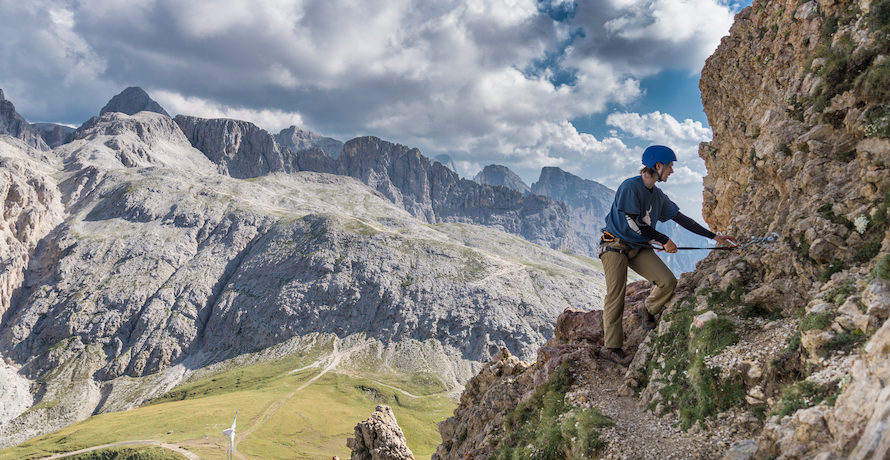These paths started out as simple iron handles and steps (in Austria, 1843) but they have become more and more modest nowadays, allowing hikers to use new and steady equipment on a majority of all Via Ferratas.
It is very natural to start off with a Via Ferrata hike before setting out to experience the real deal – hiking without protected routes.
Most hikes do not have Via Ferratas available, although it might be favourable for the newbie hikers since it requires less skills, although you need to bring equipment.
What is Via Ferrata?
“A Via Ferrata hike is a hiking path with some cheating involved”
Well not really, it’s more like a simplified hiking experience which basically everyone can partake in and complete.
If you ever considered hiking/trekking in some mountains, a Via Ferrata is one of the best ways to get started on your hiking journey. It is a play-version of the real deal. This article will go through every single aspect of Via Ferrata hikes and what you should expect from your first Via Ferrata experience.
How to get started with Via Ferrata hiking?
Getting started with Via Ferrata is quite easy, but you do however need some equipment to get going. The most essential items in a Via Ferrata kit are 3 basic items; the Via Ferrata harness, helmet & lanyard. Apart from that, you probably need some durable gloves and boots to avoid freezing and hurting yourself as you progress along a Via Ferrata route.
The routes can head downwards as well as going steeply upwards in the weirdest places imaginable.
Once you have the gear, you are good to go! But make sure to start off with an easy Via Ferrata route.
The difficulty of Via Ferratas are rated with 3-6 grades, A-C or A-F so it’s worth looking up what rating system is being used in the region where you plan to go for a Via Ferrata hike.
History of Via Ferrata
Via Ferrata means iron road in Italian and originates from WW1 when Italians built accessible paths on mountain walls using iron and rope.
However, it is believed that similar inventions have been used earlier than the 20th century. One of the first known places where a Via Ferrata was being used is the Austrian mountain Dachstein in the year of 1843.
During the First World War, Austrians and Italians were fighting for control over the Dolomites, a mountain group which is the main reason to the huge amount of Via Ferrata trails in the alps between Austria-Italy.
Apart from creating Via Ferratas, multiple tunnels were created in attempts to rig mines against the opposition’s transporting tunnels. Although the Italians and Austrians fought over a mountain territory, the harsh weather conditions were an enemy of equal significance to both sides.
A successfully detonated tunnel could give a vital edge against the enemy as food and/or fire power easily could become a casualty of an explosion.
The Via Ferratas from the Austria-Italy regions have been maintained throughout the years which means that you still can access these alps from Via Ferratas (protected paths).
Although Via Ferrata is an Italian word, it was for sure invented in Austria. Multiple Austrian mountains had Via Ferrata paths 20 years before the First World War. Austrian mountains like the Grossglockner, Zugspitze & Dachstein had Via Ferratas 50 years before the WW1 broke out.
Dolomites Via Ferratas
A majority of all Via Ferratas have been built and installed for touristic purposes, but history explains the intentions of this invention as it served as tools to maintain control over high mountain areas.
The Dolomites is the mountain group where the Via Ferratas have had a massive significance in the history of humans. If you are a history fanatic, you should definitely combine education with physical activity by visiting the Dolomites in the North-eastern Italy.
If you want a climbing experience up in the sky, check out the Mount Kenya Via Ferrata. Located 4985 meters over sea level – you are able to see elephants, leopards, and even rhinos when doing the Via Ferrata along the mountain walls.
The mountain is actually an extinct volcano just like Mount Etna volcano, so the scenery around is remarkable and the wildlife has been very affected over hundreds of years.
Via Ferrata in Switzerland
One of Austria’s neighbors, Switzerland, offers you the possibility of hiking the Aletsch Via Ferrata which indeed is a long hike with the longest suspension bridge throughout the whole Alps.
However, this Via Ferrata is quite difficult so you should only go on this Suisse hiking experience if you are an experienced mountain hiker.
An Exciting Via Ferrata
The Sacred Valley Via Ferrata is one of the coolest experiences that you can have as a hiker.
Once you get up there, you can choose to use a zip line down instead of climbing and hiking for hours. The most awesome part of the Sacred Valley Via Ferrata is that you can actually spend the night in a transparent capsule which is hanging off the mountain wall.
You’ll find a bed inside as well as small storage containers which are built-in on the inside of the capsule. On top of the adrenaline zip-line ride, you can also try out a bungee jump if you got enough guts.
